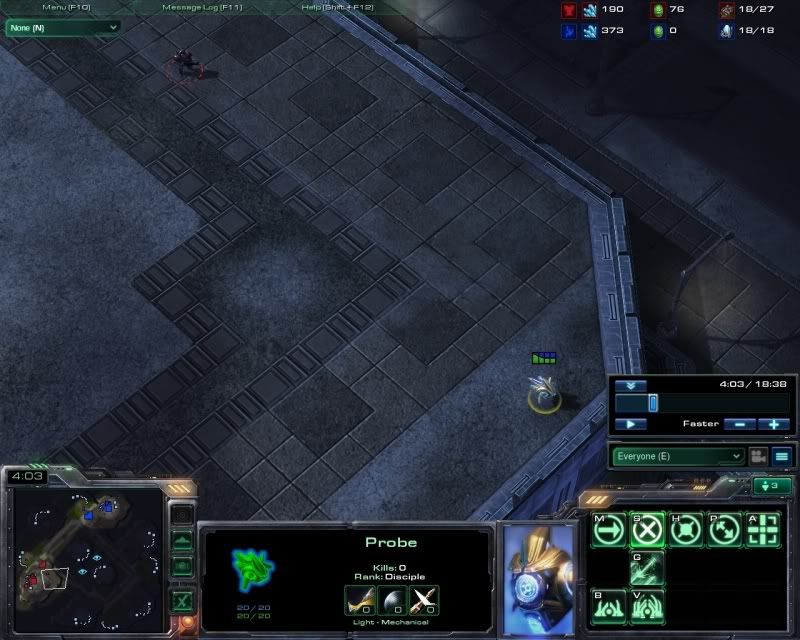
“Hmm… that Probe looks suspicious. I better question it. With my gun.”
“Speed is the essence of war. Take advantage of the enemy’s unpreparedness; travel by unexpected routes and strike him where he has taken no precautions.”
This concept will be nothing new for StarCraft players. On a conceptual level, things of this nature have existed since gaming began. From the shark at the blackjack table to the RPG player grinding a particular area over & over again, gamers like to game and some especially like to game the system. Sometimes, this is referred to as cheating or exploiting. StarCraft has a particular term for it. They call it cheese.
Cheese is a strategy for opening a game that looks to take advantage of a timing or mechanics advantage you might have over your opponent. While it’s not the same as going all-in on a particular strategy, if your cheese fails you can end up at a severe disadvantage economically. Many cheeses also involve a measure of micro-management, pulling your focus away from establishing the foundation for longer play. If you invest in cheese up-front and don’t follow up with a solid mid-game, your clever strategy might actually become the reason you lose the game.
Let me give you an example from each race.
Protoss: Proxy Pylon
The basic infantry units of the Protoss – Zealots, Stalkers, etc – are produced at Gateways, which can be converted to Warp Gates. When they become Warp Gates, the buildings can teleport units into play anywhere the Protoss have built a Pylon. Pylons require minimal investment, can be built anywhere and, like all Protoss buildings, do not require a Probe to be present while completing construction.
The cheese in this comes when the Protoss player builds a Pylon far from his home, in or near the enemy base. On some maps, the geography allows the Pylon to sit out of the enemy’s sight while its power grid, the area which powers Protoss buildings & provides space for the aforementioned units to warp in, intrudes into the enemy base. A Protoss player can warp in units at his leisure or even build Plasma Cannons to destroy their opponent’s economy, wreck their buildings and generally be a nuiscance.
Terran: Planetary Fortress Rush
It may seem a bit silly, but a Terran player can use their initial base structure as an offensive unit. The Command Center has the option to be upgraded to either an Orbital Command or a Planetary Fortress. The latter upgrade beefs the building up with layers of armor and adds a pair of cannons on a turret on top. After upgrading to the Planetary Fortress, the building cannot lift off again as most Terran buildings do.
The thrust of this opening is for the Terran player to build a second Command Center as soon as possible, float it into the enemy base, drop it in place with a few SCVs for repairs and upgrade directly to the Planetary Fortress. After the enemy workers have been eliminated, the Terran player’s own workers can acquire the resources of the enemy base while the Fortress blasts anything that tries to take it down. It is meant to capitalize more on psychological impact than any practical issues like longer game strategy or unit counters.
Zerg: Zergling Rus
It’s a StarCraft tradition. The Zerg rush has been used so often and so effectively that the term has seeped into other games and aspects of culture. Zerglings are the least costly of the initial starting units of all three races, and the nature of Zerg unit production allows for many of the units to be produced at once. Take a bunch of these little guys, produced as quicly as possible, and point them in the general direction of whatever you want consumed.
The basic strategy is alive, well, and relatively unchanged from the original game. The Zerg player puts down a Spawning Pool with all due haste. The initial batch of Zerglings then speed their way to the enemy base. A half-dozen Zerglings can absolutely gut the economy of an unwary player in the very early game. It relies on quick scouting and constant unit production.
Beating Cheese
Getting around cheese is actually relatively simple. Maintain strong macro, scout your base and move aggressively against any encroachment. If you are constantly building units, even the most basic fighters, most early opening cheese won’t lost too long. Keep a unit, be it a builder or something more robust, peeking out from your base and coming back just to make sure the enemy doesn’t get any bright ideas. And if you do see a builder or a couple units whistling innocently as they approach our base, stomp them as quickly as possible. That shoul take care of most cheese, but sometimes, you just won’t get your placement exactly right and those Zerglings will slip through, or you’ll scout your entire perimeter only to just miss the Pylon about to dispense unpleasantness on your buildings. Keep playing & practicing, and it’ll happen less often.



Leave a Reply